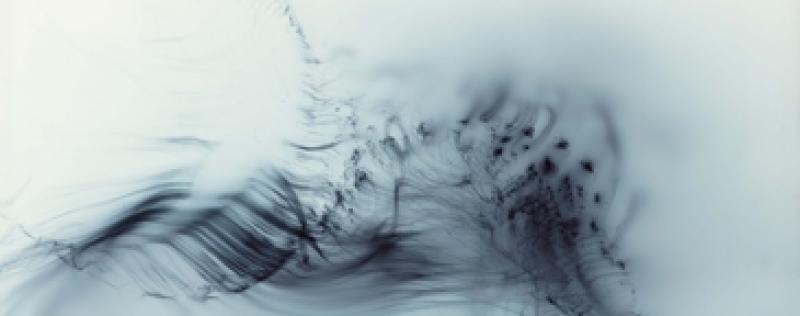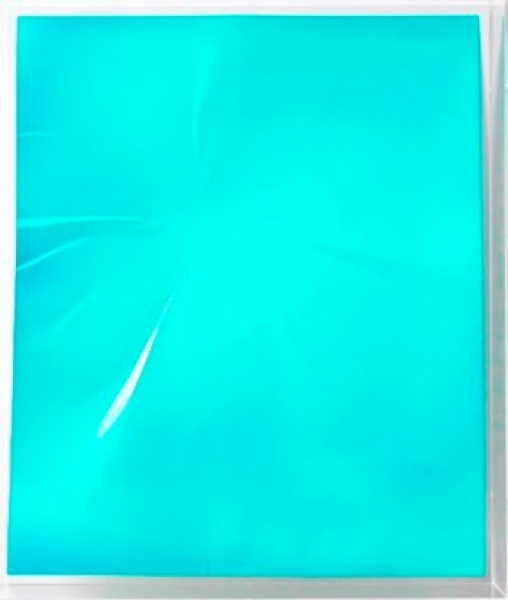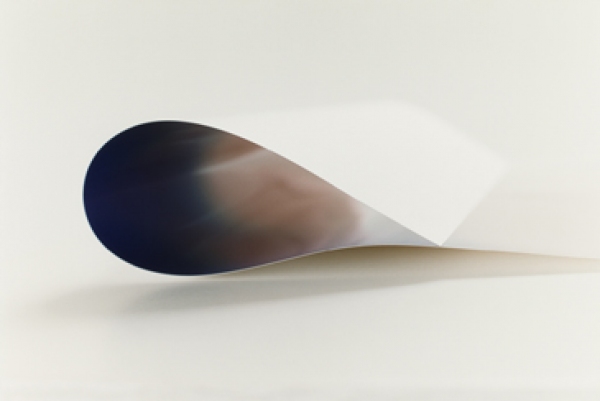Wolfgang Tillmans, Serpentine Gallery | reviews, news & interviews
Wolfgang Tillmans, Serpentine Gallery
Wolfgang Tillmans, Serpentine Gallery
Tillmans is too laid back to care at the Serpentine.

It takes a lot of work to make a show look as unconsidered and chaotic as this one: thought and care and time and attention all have to be paid before something so random can be achieved. But as so often with Tillmans, the nagging questions persist: is randomness, are the offhand and the casual, valid as ends in themselves? Because Tillman’s über-hip affectless cool has become very tiresome indeed. Even worse, it’s becoming predictable and dull.
Some of the most recent images are arresting, and the play of scale and form interact well: the print of a façade of a rough-cast house, ready for stuccoing, interestingly mimics and echoes the hyper-sized egg-cartons in the next print. But what to make of the adjacent print, a heptathlete waiting at the starting blocks, a rather ordinary slice-of-life piece of photo-journalism, next to the formal beauty and technologically interesting inkjet print Nanbei Hu? What is the point of the four images side-by-side? Try as I might, the only answer I can come up with is this: the point is that there is no point. And that ultimately, I’m afraid, strikes me as a rather uninteresting response, as well as disdainful of viewers who have by contrast treated the artist’s work with respect, by giving it serious consideration.  Other series Tillmans has been working on for some time. The Lighter images use photographic paper as quasi sculpture, the stiffened paper crumpled and bent to create pleasantly minimalistic shapes under Perspex (Lighter Blue, concave I, pictured right) These are attractive, and will be enjoyed by lovers of minimalism, myself included. Then there are a series of prints created in the darkroom, using the modified light and the printing processes of photography, but doing away with the preliminary camera-work. Ostgut Freischwimmer right (main picture), is vast – over 6 meters by 2 - and its rhythms and shapes are potent, while its size permits the viewer to sink into the image. No doubt there are great swathes to be written about the play of technology, the irony of camera-less photography, just as the close-up large-scale images from the Paper Drop series (Paper drop, (Roma), pictured below left), is a likely jumping-off point for discussions of materiality of photography versus sculptural objectivity.
Other series Tillmans has been working on for some time. The Lighter images use photographic paper as quasi sculpture, the stiffened paper crumpled and bent to create pleasantly minimalistic shapes under Perspex (Lighter Blue, concave I, pictured right) These are attractive, and will be enjoyed by lovers of minimalism, myself included. Then there are a series of prints created in the darkroom, using the modified light and the printing processes of photography, but doing away with the preliminary camera-work. Ostgut Freischwimmer right (main picture), is vast – over 6 meters by 2 - and its rhythms and shapes are potent, while its size permits the viewer to sink into the image. No doubt there are great swathes to be written about the play of technology, the irony of camera-less photography, just as the close-up large-scale images from the Paper Drop series (Paper drop, (Roma), pictured below left), is a likely jumping-off point for discussions of materiality of photography versus sculptural objectivity.
 But it’s a fine line between presenting a discussion of the open-ended nature of installation and presenting an exhibition of sheer aimlessness, between attempting to create an image of slice-of-life reality and creating the blankness of point-and-click photography. The desire to capture the transience of an evanescent reality can instead all too easily come across as affectlessness, just as Tillmans’s chronic juxtapositions of scale, his carefully judged construction of careless slap-it-on-the-wall installations can seem to show disdain for his viewers. And to me this show falls on the wrong side of all these lines. From so laid back it’s hip to so laid back it’s dull is not a big step, but it is one that Tillmans in the Serpentine has all too obviously taken.
But it’s a fine line between presenting a discussion of the open-ended nature of installation and presenting an exhibition of sheer aimlessness, between attempting to create an image of slice-of-life reality and creating the blankness of point-and-click photography. The desire to capture the transience of an evanescent reality can instead all too easily come across as affectlessness, just as Tillmans’s chronic juxtapositions of scale, his carefully judged construction of careless slap-it-on-the-wall installations can seem to show disdain for his viewers. And to me this show falls on the wrong side of all these lines. From so laid back it’s hip to so laid back it’s dull is not a big step, but it is one that Tillmans in the Serpentine has all too obviously taken.
- Wolfgang Tillmans at the Serpentine Gallery until 19 September
Share this article
The future of Arts Journalism
You can stop theartsdesk.com closing!
We urgently need financing to survive. Our fundraising drive has thus far raised £49,000 but we need to reach £100,000 or we will be forced to close. Please contribute here: https://gofund.me/c3f6033d
And if you can forward this information to anyone who might assist, we’d be grateful.

Subscribe to theartsdesk.com
Thank you for continuing to read our work on theartsdesk.com. For unlimited access to every article in its entirety, including our archive of more than 15,000 pieces, we're asking for £5 per month or £40 per year. We feel it's a very good deal, and hope you do too.
To take a subscription now simply click here.
And if you're looking for that extra gift for a friend or family member, why not treat them to a theartsdesk.com gift subscription?
more Visual arts
 'We are bowled over!' Thank you for your messages of love and support
Much-appreciated words of commendation from readers and the cultural community
'We are bowled over!' Thank you for your messages of love and support
Much-appreciated words of commendation from readers and the cultural community
 Photo Oxford 2025 review - photography all over the town
At last, a UK festival that takes photography seriously
Photo Oxford 2025 review - photography all over the town
At last, a UK festival that takes photography seriously
![SEX MONEY RACE RELIGION [2016] by Gilbert and George. Installation shot of Gilbert & George 21ST CENTURY PICTURES Hayward Gallery](https://theartsdesk.com/sites/default/files/styles/thumbnail/public/mastimages/Gilbert%20%26%20George_%2021ST%20CENTURY%20PICTURES.%20SEX%20MONEY%20RACE%20RELIGION%20%5B2016%5D.%20Photo_%20Mark%20Blower.%20Courtesy%20of%20the%20Gilbert%20%26%20George%20and%20the%20Hayward%20Gallery._0.jpg?itok=7tVsLyR-) Gilbert & George, 21st Century Pictures, Hayward Gallery review - brash, bright and not so beautiful
The couple's coloured photomontages shout louder than ever, causing sensory overload
Gilbert & George, 21st Century Pictures, Hayward Gallery review - brash, bright and not so beautiful
The couple's coloured photomontages shout louder than ever, causing sensory overload
 Lee Miller, Tate Britain review - an extraordinary career that remains an enigma
Fashion photographer, artist or war reporter; will the real Lee Miller please step forward?
Lee Miller, Tate Britain review - an extraordinary career that remains an enigma
Fashion photographer, artist or war reporter; will the real Lee Miller please step forward?
 Kerry James Marshall: The Histories, Royal Academy review - a triumphant celebration of blackness
Room after room of glorious paintings
Kerry James Marshall: The Histories, Royal Academy review - a triumphant celebration of blackness
Room after room of glorious paintings
 Folkestone Triennial 2025 - landscape, seascape, art lovers' escape
Locally rooted festival brings home many but not all global concerns
Folkestone Triennial 2025 - landscape, seascape, art lovers' escape
Locally rooted festival brings home many but not all global concerns
 Sir Brian Clarke (1953-2025) - a personal tribute
Remembering an artist with a gift for the transcendent
Sir Brian Clarke (1953-2025) - a personal tribute
Remembering an artist with a gift for the transcendent
 Emily Kam Kngwarray, Tate Modern review - glimpses of another world
Pictures that are an affirmation of belonging
Emily Kam Kngwarray, Tate Modern review - glimpses of another world
Pictures that are an affirmation of belonging
 Kiefer / Van Gogh, Royal Academy review - a pairing of opposites
Small scale intensity meets large scale melodrama
Kiefer / Van Gogh, Royal Academy review - a pairing of opposites
Small scale intensity meets large scale melodrama
 Jenny Saville: The Anatomy of Painting, National Portrait Gallery review - a protégé losing her way
A brilliant painter in search of a worthwhile subject
Jenny Saville: The Anatomy of Painting, National Portrait Gallery review - a protégé losing her way
A brilliant painter in search of a worthwhile subject
 Abstract Erotic, Courtauld Gallery review - sculpture that is sensuous, funny and subversive
Testing the boundaries of good taste, and winning
Abstract Erotic, Courtauld Gallery review - sculpture that is sensuous, funny and subversive
Testing the boundaries of good taste, and winning
 Edward Burra, Tate Britain review - watercolour made mainstream
Social satire with a nasty bite
Edward Burra, Tate Britain review - watercolour made mainstream
Social satire with a nasty bite

Add comment